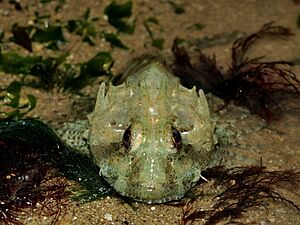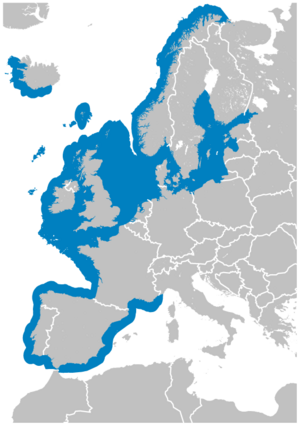Longspined bullhead facts for kids
Quick facts for kids Longspined bullhead |
|
|---|---|
 |
|
| Longspined bullhead. Photographed at Scarborough, North Yorkshire | |
| Conservation status | |
| Scientific classification | |
 |
|
| Longspined bullhead range. | |
| Synonyms | |
|
The long-spined bullhead (Taurulus bubalis) is a cool coastal fish that lives in the seas around Europe. It's also known as the long-spined sea-scorpion or long-spined scorpion fish. This fish belongs to the sculpin family, called Cottidae.
Contents
About the Long-Spined Bullhead
How it Got its Name
The long-spined bullhead was first officially described in 1786. A Swedish biologist named Bengt Anders Euphrasén gave it the scientific name Cottus bubalis. He found it in a place called Bohuslän in Sweden.
Later, in 1907, a Russian fish expert named Valerii Ivanovich Gratzianov placed this fish into its own special group, Taurulus. Today, Taurulus is recognized as its own genus, which is a group of closely related species.
What it Looks Like
The long-spined bullhead is a small fish. It has a thick body that gets thinner towards its tail. It also has a very large head. It looks a bit like another fish called the shorthorn sculpin.
This fish has two spines on each side of its gill cover. The front spine is longer than the one behind it. Its skin is smooth and does not have scales. Along its side, it has a line of bony bumps. There are also bony bumps on top of its head that point backwards.
Long-spined bullheads come in different colors. They can be shades of brown or olive green. They often have cream-colored blotches and four dark stripes going up and down their bodies. Their belly is usually a pale bluish-green. However, during the breeding season, the males' bellies turn reddish.
How it Behaves
Long-spined bullheads are predators. This means they hunt and eat other creatures. They like to eat prawns, molluscs (like snails or clams), and small fish such as gobies and blennies. Even though they are small, they can be quite aggressive. They will even attack fish that are bigger than them!
These fish are very good at camouflage. They hide among rocks and seaweed, blending in with their surroundings. They wait patiently for prey to swim by, then they quickly strike out to catch it.
Unlike many other fish, the bullhead does not have a swim bladder. A swim bladder is a gas-filled organ that helps fish float. Because the bullhead doesn't have one, it sinks as soon as it stops swimming. This means it has to keep moving to stay off the bottom.
Reproduction
Long-spined bullheads usually breed in early spring. The eggs are fertilized inside the female. She then lays the eggs among algae. The adult fish guard the eggs to keep them safe.
Once the baby fish, called fry, hatch, they swim out to sea for a while. After they grow a bit, they return to live closer to the coast. Scientists are still studying the full details of how these fish reproduce.
You can find long-spined bullheads from areas where the tide goes in and out, all the way down to about 30 meters (about 100 feet) deep. They are most commonly found along the coast.
Other Names for This Fish
People call the long-spined bullhead by several other names. These include sea scorpion, bullhead, rockfish, rock sculpin, and clobberhead.


